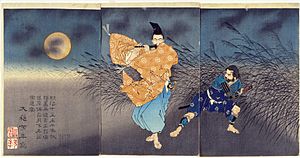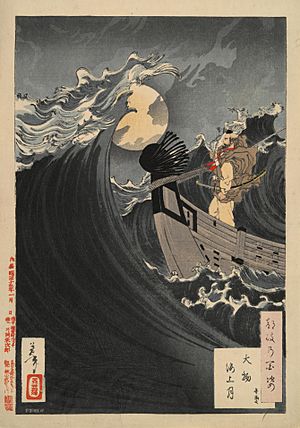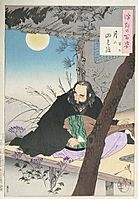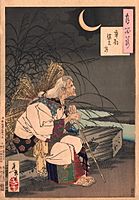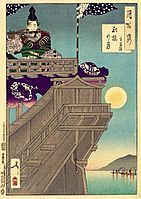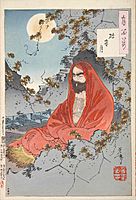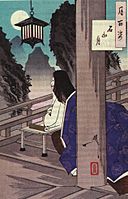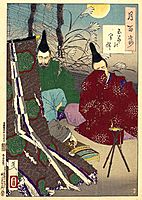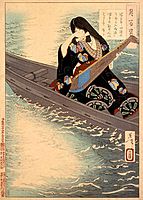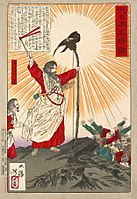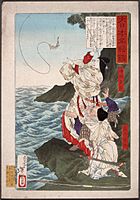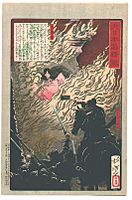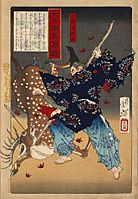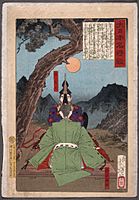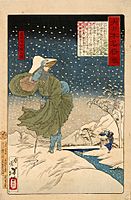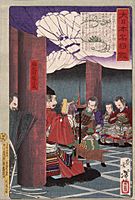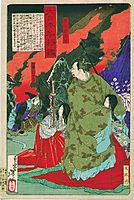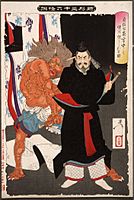Tsukioka Yoshitoshi facts for kids
Quick facts for kids
Tsukioka Yoshitoshi
|
|
|---|---|
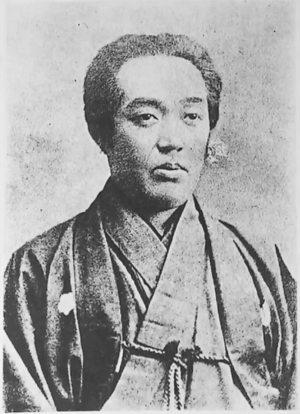
Tsukioka c. 1882
|
|
| Born | 30 April 1839 |
| Died | 9 June 1892 (aged 53) |
| Known for | Ukiyo-e |
| Spouse(s) |
Sakamaki Taiko
(m. 1884) |
Tsukioka Yoshitoshi (Japanese: 月岡 芳年; also known as Taiso Yoshitoshi 大蘇 芳年; born April 30, 1839 – died June 9, 1892) was a famous Japanese artist. He made amazing prints using woodblock printing.
Yoshitoshi is known as the last great master of ukiyo-e art. Ukiyo-e is a style of Japanese art, often showing everyday life or famous people. He was also very creative and brought new ideas to this art form.
His career happened during a big change in Japan. It started in the last years of the Edo period and continued into modern Japan after the Meiji Restoration. Yoshitoshi was interested in new things from other countries. But he also worried about losing traditional Japanese culture, like woodblock printing.
Even as Japan started using new ways to make pictures, like photography, Yoshitoshi kept the old woodblock print art alive. He pushed it to new levels before it slowly faded away after his death. Today, many people see him as the greatest Japanese artist of his time.
Contents
- Yoshitoshi's Early Life and Training
- The "Bloody Prints": Capturing Attention
- Middle Years: Hardship and Comeback
- Later Years: The Decline of Ukiyo-e
- Looking Back at Yoshitoshi's Art
- Print Series by Yoshitoshi
- One Hundred Aspects of the Moon Series
- Mirror of Famous Generals of Great Japan Series
- Other Notable Artworks
- See also
Yoshitoshi's Early Life and Training
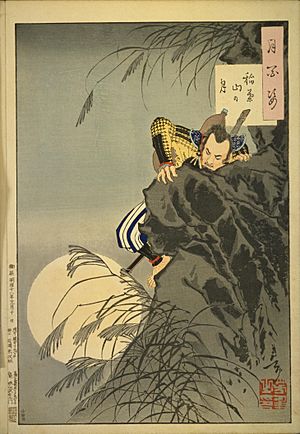
Yoshitoshi was born in 1839 in a part of old Edo called Shimbashi. His first name was Owariya Yonejiro. His father was a rich merchant who had become a samurai. When Yoshitoshi was three, he went to live with his uncle, who was a pharmacist. His uncle loved him very much.
At age five, Yoshitoshi became interested in art. He started taking lessons from his uncle. In 1850, when he was 11, Yoshitoshi became a student of Utagawa Kuniyoshi. Kuniyoshi was a very famous master of Japanese woodblock prints. Kuniyoshi gave him the artist name "Yoshitoshi." This showed he was part of the Utagawa School of art. Many people now see Yoshitoshi as Kuniyoshi's most important student.
During his training, Yoshitoshi worked hard to improve his drawing skills. He copied his teacher's sketches. Kuniyoshi taught him to draw from real life. This was unusual in Japan at the time. Artists usually focused on the feeling of a subject, not just how it looked. Yoshitoshi also learned Western drawing styles. He studied foreign prints and engravings from Kuniyoshi's collection.
Yoshitoshi's first print came out in 1853. But he didn't make many more for a while. This might have been because his teacher Kuniyoshi was sick. After Kuniyoshi died in 1861, Yoshitoshi's life was tough. But he still made some art. He created 44 prints in 1862. In the next two years, 63 of his designs were published. Most of these were about kabuki theater. He also helped with a series called Tokaido in 1863.
The "Bloody Prints": Capturing Attention
Many of Yoshitoshi's prints from the 1860s showed strong scenes of violence and death. These ideas came partly from his father's death in 1863. They also came from the difficult times in Japan. The old feudal system was breaking down. Japan was also starting to interact with Western countries.
In late 1863, Yoshitoshi began drawing violent pictures. These became battle prints with a dramatic and bloody style. People liked these prints, and Yoshitoshi became more famous. Japan was at war, and his images let people feel like they were part of the action. People liked his work because of his great drawing skills and his strong feelings about his subjects.
As he became more well-known, 95 more of his designs were published in 1865. These were mostly about war and history. Two series showed his creativity. One was Tsūzoku saiyūki ("A Modern Journey to the West"), about a Chinese hero. The other was Wakan hyaku monogatari ("One Hundred Stories of China and Japan"), which showed traditional ghost stories.
Between 1866 and 1868, Yoshitoshi made some intense images. One famous series was Eimei nijūhasshūku ("Twenty-eight famous murders with verse"). In 1868, after the Battle of Ueno, he made Kaidai hyaku sensō. This series showed soldiers from his time as historical figures. He used close-up views and unusual angles. The soldiers often looked desperate in battle.
Yoshitoshi's "bloody" prints influenced later artists and writers. But these prints are only a small part of all the art he created.
Middle Years: Hardship and Comeback
By 1869, Yoshitoshi was seen as one of Japan's best woodblock artists. But soon after, he stopped getting art jobs. Maybe people were tired of violent scenes. By 1871, Yoshitoshi became very sad and had a difficult personal life. This continued on and off until he died.
He lived in very poor conditions with his girlfriend, Okoto. She sold her clothes and things to support him. At one point, they had to burn floorboards from their house to stay warm. It is said that in 1872, he had a complete mental breakdown. This happened after his new designs were not popular.
In 1873, his luck changed. His mood improved, and he started making more prints. Before this, he signed most prints as "Ikkaisai Yoshitoshi." But now, he changed his artist name to "Taiso." This name means "great resurrection" or "big comeback."
Newspapers started appearing as Japan modernized. Yoshitoshi was hired to make "news nishikie." These were woodblock prints that illustrated articles. They often showed exciting or shocking stories, like true crime.
When the Satsuma Rebellion happened in 1877, newspaper sales went way up. This rebellion was a last attempt by the old feudal system to stop modern Japan. Woodblock artists were in high demand, and Yoshitoshi became very popular. His art brought him more public recognition and money. But he didn't feel truly secure until 1882.
In 1878, he designed a series of bijin-ga (pictures of beautiful women) called Bijin shichi yoka. This caused some political trouble. It showed seven women who worked for the Imperial court and named them. It's possible that the Empress Meiji herself was not happy with this.
From 1877 to 1882, Yoshitoshi published "Mirror of Famous Generals of Great Japan." This series had 51 works. It showed great men from Japanese history and myths. This helped his reputation grow even more.
In 1880, he met Sakamaki Taiko, a former geisha with two children. They married in 1884. Even though he sometimes had other relationships, her calm and patient nature seemed to help him. One of Taiko's children became Yoshitoshi's student. He was then known as Tsukioka Kōgyo.
In 1883, Yoshitoshi published "Fujiwara no Yasumasa Gekka Roteki zu" (Fujiwara no Yasumasa Playing the Flute). This ukiyo-e print was based on a drawing he showed at an exhibition. It tells a story from old Japanese tales. It shows a bandit, Hakamadare, trying to attack Fujiwara no Yasumasa. But Yasumasa is playing his flute, and his calm presence stops the bandit. This work is considered one of Yoshitoshi's best.
Yoshitoshi's famous print, “Oshu adachigahara hitotsuya no zu” (The Lonely House on Adachi Moor), came out in 1885. This art shows the legend of kijo (a demon woman) from the story of Kurozuka. This story is also performed in traditional Japanese theater like noh and kabuki.
In 1885, an art magazine called "Tokyo Hayari Hosomiki" named Yoshitoshi the number-one ukiyo-e artist. He was ranked above other famous artists of his time. This showed he was very popular and respected.
By this time, the woodblock printing industry was struggling. Many great artists had died years before. Woodblock prints were slowly disappearing as Japan became more modern.
Yoshitoshi insisted on high-quality work. He helped keep the art form from getting worse for a while. He became a great teacher. Some of his notable students were Toshikata Mizuno and Toshihide Migita.
Later Years: The Decline of Ukiyo-e
His last years were some of his busiest. He created his amazing series One Hundred Aspects of the Moon (1885–1892). He also made New Forms of Thirty-Six Ghosts (1889–1892). He also created beautiful triptychs (three-panel prints) of kabuki theater actors and scenes.
During this time, he worked with his friend, the actor Ichikawa Danjūrō. They tried to save some traditional Japanese arts.
In his last years, his mental health problems returned. In early 1891, he invited friends to an art gathering that wasn't real. His physical health also got worse. To make things worse, all his money was stolen from his home. After more health issues, he was admitted to a mental hospital. He left in May 1892 but did not go home. Instead, he rented new rooms.
He died three weeks later, on June 9, 1892, in a rented room. He was 53 years old. He died from a brain hemorrhage. A stone monument to Yoshitoshi was built in a garden in Tokyo in 1898.
Looking Back at Yoshitoshi's Art
During his life, Yoshitoshi made many series of prints. He also created many triptychs, which are prints made of three parts. Many of these are very good. Two of his most famous series are One Hundred Aspects of the Moon and Thirty-Six Ghosts. These have many masterpieces. His series Thirty-Two Aspects of Customs and Manners was once considered his best, but it's not seen that way as much now. Other less common series also have great prints. These include Famous Generals of Japan and New Selection of Eastern Brocade Pictures.
For a few years after he died, people still wanted his prints. But then, interest in his work faded in Japan and around the world. Many people thought that the artists from the time of Hiroshige were the last great woodblock artists.
However, in the 1970s, people started to become interested in Yoshitoshi again. Experts looked at his work again and saw how good, original, and brilliant it was. They realized how well he kept the best parts of old Japanese woodblock prints. He also pushed the art form forward by adding new ideas from the West and his own creative touches.
Print Series by Yoshitoshi
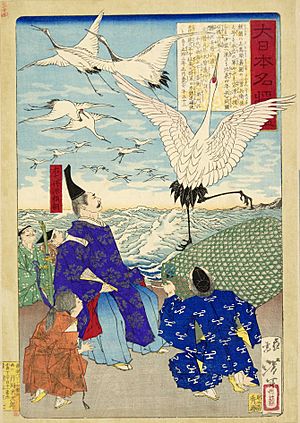
Here is a list of some of his print series, with the years they were made:
- One Hundred Stories of Japan and China (1865–1866)
- Biographies of Modern Men (1865–1866)
- Twenty-Eight Famous Murders with Verses (1866–1869)
- One Hundred Warriors (1868–1869)
- Biographies of Drunken Valiant Tigers (1874)
- Mirror of Beauties Past and Present (1876)
- Mirror of Famous Generals of Great Japan (1876–1882)
- A Collection of Desires (1877)
- Eight Elements of Honor (1878)
- Warriors Trembling with Courage (1883–1886)
- Yoshitoshi Manga (1885–1887)
- One Hundred Aspects of the Moon (1885–1892)
- Personalities of Recent Times (1886–1888)
- Thirty-Two Aspects of Customs and Manners (1888) "Fuzoku sanjuniso – Aitasou"
- New Forms of Thirty-Six Ghosts (1889–1892)
One Hundred Aspects of the Moon Series
Yoshitoshi's series One Hundred Aspects of the Moon has one hundred woodblock prints. He made these in his later years, between 1885 and 1892. Even though some prints don't show the moon, it's a main idea that connects the whole series.
Mirror of Famous Generals of Great Japan Series
Yoshitoshi's series Mirror of Famous Generals of Great Japan has fifty-one woodblock prints. He made these in his middle years, between 1877 and 1882.
-
A picture of Emperor Jimmu with his bow and a three-legged crow.
-
Empress Jingu and Takenouchi no Sukune.
-
Saimyō-ji Tokiyori (also known as Hōjō Tokiyori).
Other Notable Artworks
-
New Forms of Thirty-Six Ghosts: Lord Sadanobu (Fujiwara no Tadahira) threatening a demon.
See also
 In Spanish: Yoshitoshi para niños
In Spanish: Yoshitoshi para niños
- Night in paintings (Eastern art), including One Hundred Aspects of the Moon



